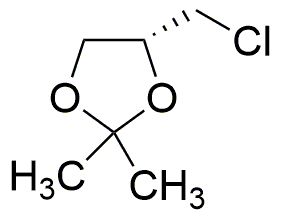(R)-4-Chloromethyl-2,2-dimethyl-1,3-dioxolane is widely utilized in research focused on:
- Synthesis of Fine Chemicals: This compound serves as a versatile intermediate in the synthesis of various fine chemicals, particularly in the pharmaceutical industry, where it can be used to create complex molecules with specific biological activities.
- Development of Agrochemicals: It plays a role in the formulation of agrochemicals, enhancing the efficacy of pesticides and herbicides, which helps in improving crop yields and protecting plants from pests.
- Polymer Chemistry: This chemical is used in the production of specialty polymers, contributing to materials with unique properties such as improved durability and resistance to environmental factors.
- Research in Organic Synthesis: Researchers utilize it as a building block in organic synthesis, facilitating the creation of novel compounds for various applications, including drug discovery and materials science.
- Chiral Auxiliary in Asymmetric Synthesis: Its chiral nature makes it valuable as a chiral auxiliary, aiding in the production of enantiomerically pure compounds, which is crucial in the development of pharmaceuticals.
General Information
Properties
Safety and Regulations
Applications
(R)-4-Chloromethyl-2,2-dimethyl-1,3-dioxolane is widely utilized in research focused on:
- Synthesis of Fine Chemicals: This compound serves as a versatile intermediate in the synthesis of various fine chemicals, particularly in the pharmaceutical industry, where it can be used to create complex molecules with specific biological activities.
- Development of Agrochemicals: It plays a role in the formulation of agrochemicals, enhancing the efficacy of pesticides and herbicides, which helps in improving crop yields and protecting plants from pests.
- Polymer Chemistry: This chemical is used in the production of specialty polymers, contributing to materials with unique properties such as improved durability and resistance to environmental factors.
- Research in Organic Synthesis: Researchers utilize it as a building block in organic synthesis, facilitating the creation of novel compounds for various applications, including drug discovery and materials science.
- Chiral Auxiliary in Asymmetric Synthesis: Its chiral nature makes it valuable as a chiral auxiliary, aiding in the production of enantiomerically pure compounds, which is crucial in the development of pharmaceuticals.
Documents
Safety Data Sheets (SDS)
The SDS provides comprehensive safety information on handling, storage, and disposal of the product.
Product Specification (PS)
The PS provides a comprehensive breakdown of the product’s properties, including chemical composition, physical state, purity, and storage requirements. It also details acceptable quality ranges and the product's intended applications.
Certificates of Analysis (COA)
Search for Certificates of Analysis (COA) by entering the products Lot Number. Lot and Batch Numbers can be found on a product’s label following the words ‘Lot’ or ‘Batch’.
*Catalog Number
*Lot Number
Certificates Of Origin (COO)
This COO confirms the country where the product was manufactured, and also details the materials and components used in it and whether it is derived from natural, synthetic, or other specific sources. This certificate may be required for customs, trade, and regulatory compliance.
*Catalog Number
*Lot Number
Safety Data Sheets (SDS)
The SDS provides comprehensive safety information on handling, storage, and disposal of the product.
DownloadProduct Specification (PS)
The PS provides a comprehensive breakdown of the product’s properties, including chemical composition, physical state, purity, and storage requirements. It also details acceptable quality ranges and the product's intended applications.
DownloadCertificates of Analysis (COA)
Search for Certificates of Analysis (COA) by entering the products Lot Number. Lot and Batch Numbers can be found on a product’s label following the words ‘Lot’ or ‘Batch’.
*Catalog Number
*Lot Number
Certificates Of Origin (COO)
This COO confirms the country where the product was manufactured, and also details the materials and components used in it and whether it is derived from natural, synthetic, or other specific sources. This certificate may be required for customs, trade, and regulatory compliance.


